I didn’t realize it at the time, but these two clips about Cary Leibowitz and Joep van Lieshout end up being related. Both artists make work that directly questions the value that the “Art” label imbues to an object. And though Cary comes at it from a position of artist neediness and Joep from defiant bravado, both address the issue of whether an “Art” object should be preserved.
Which is interesting, since I think MoMA threw out the van Lieshouts they commissioned when they built their new building.
And yeah, no, I don’t know why the YouTube stills for all my videos are green, either. It’s not like I whipped together a faux Flavin in the auditorium or anything.
All Visiting Artist [sic] posts:
Parts 2 & 3: On Dan Flavin
Parts 4 & 5: On Throwing Art Away
video of Part 6: On Joep van Lieshout, which I apparently didn’t post here
Parts 7 & 7 [sic] on Robert Smithson
Category: projects
Visiting Artist [sic], Parts 2 & 3: Dan Flavin
In April 2007, I spoke at the University of Utah as part of their Visiting Artist lecture series.
I was stoked, partly because Robert Smithson had famously spoken at the UofU, too, in 1969; his lecture and slideshow, “Hotel Palenque,” became an influential part of Smithson’s canon, and it’s a personal favorite of mine. After his death, the recording of the lecture declared a work, a “multimedia installation” which has been exhibited in museums and was acquired by the Guggenheim.
I took this somewhat problematic transformation as an inspiration for both my topic and my work. So I rounded up some other examples of how money and attention have impacted contemporary artworks after they have left the artists’ studios. Then in homage to the hilariously crappy film version of “Hotel Palenque” shot from the audience [it can be viewed in its wobbly entirety on Ubu, which describes it as a “Bootleg film/ documentation / artwork by Alex Hubbard”] I gave my younger brother my video camera, and told him to just let it roll.
The lesson was that money and the market will have its way with your work anyway, so you might as well prepare for it; so at the end, I told the audience that in order to remove any ambiguity in the future, I was officially declaring the lecture to be a work, my first in what Paul Morrissey described as “the medium of the lecture circuit.” So I passed around a stack of signed, numbered certificates of authenticity. 46 people took them.
Anyway, I thought the tape was lost immediately after the lecture, but then this weekend, just after the work’s 2-year anniversary, I found it in a bag. So I’m ripping it and posting the various segments of the talk on YouTube.
First up: Parts 2&3, Dan Flavin [I’ll post Part 1, my intro, but I can’t bring myself to intro it.]
In these two segments, I recapped some of the things I found while writing about Flavin’s work for the NY Times in 2005, including how collectors are fetishizing vintage hardware over the artist’s preferred newness, and how the Estate has adapted to that demand, as well as to the discontinuation of Flavin’s original light bulbs and fixtures.
Future segments will look at The Gates, Cary Liebowitz’s work, MoMA and the work of Joep van Lieshout, and changes to Smithson’s Palenque and Spiral Jetty. Stay tuned.
All Visiting Artist [sic] posts:
Parts 2 & 3: On Dan Flavin
Parts 4 & 5: On Throwing Art Away
video of Part 6: On Joep van Lieshout, which I apparently didn’t post here
Parts 7 & 7 [sic] on Robert Smithson
Previously: notes from my interview with Stephen Flavin, which didn’t get to me in time to make the NYT
notes from my interview with Emily Rauh Pulitzer, an early curator and collector of Flavin’s work, also not completed in time to make the Times
on visiting Flavin’s 2004 retrospective at the NGA
Also: Andy Warhol sent an impostor on a college lecture tour in the West; student reporters from the U of U unmasked him, in three parts, I, II, and III [note: U of U student Michelle Condrat researched the historical unfolding of the Fake Warhol Lecture Scandal]
See. The Artist. Be. The Artist.
Dan Fox, an editor at Frieze, has a long but excellent essay? article? exploration? of what it means to be a “professional artist.”
How should artists behave? How should we discuss art, build venues to show it in, tell people about it, try and support artists? There is no single answer: each situation demands a different solution. Perhaps, as we are hit daily with dire economic news, what is needed is to remain sensitive to the details, those small elements in the art world that cumulatively exert their own pressures on the ways in which people behave or relate to the making of art.
As my projects and interests have become increasingly some combination of quixotic, ridiculous, and conceptual, I’m left with the reality that the only rubric to justify their existence or realization is “art.”
But as someone who’s been wandering through the art and gallery and museum worlds for so long in the guise of anything-but-artist, I find defining myself as an artist to be problematic at best, mostly because of many of the issues Fox identifies: I’ve never sold a work. I don’t support myself through making or selling my work. I can barely imagine the idea of making saleable work [though if you’re in the market for a 100-foot satelloon, I’m sure we can work something out.] I was in a gallery show, but I don’t have or seek the external validation of an authoritative figure such as a dealer, critic, or curator. I’m an art history undergrad with an MBA where my MFA should be, and an art writer with a few NY Times bylines where my October credits should be.
If I were a “professional artist,” I’d immediately consider myself an abject failure, and my collecting, writing, fundraising, and curating reflexes would tell me to ignore my credential-less, dilettante-ish loser self.
So no, even with the art market evaporating like dew in the morning sun, I’m not too sanguine yet with the definitional aspects of being a professional artist. Still, good reading.
A Serious Business | What does it mean to be a professional artist? [frieze.com via c-monster]
Oh Mighty ISIS!
It seems the Pentagon has gotten wind of my master plan to re-create satelloons, the giant, inflated satellites with the integrated reflective communications capability, and they’re trying to beat me to the punch with a $400 million, 450-foot-long, inflated surveillance “airship” which would operate for up to 10 years at an altitude of 65,000 feet:
The Air Force has signed an agreement with DARPA to develop a demonstration dirigible by 2014. The prototype will be a third as long as the planned surveillance craft — known as ISIS, for Integrated Sensor Is the Structure, because the radar system will be built into the structure of the ship.
Uh, shouldn’t that be ISITS? Who names these things? Isn’t including “is” in your acronym cheating, like using all monosyllabic words in your haiku? But whatever, 150-foot prototype!
Pentagon plans blimp to spy from new heights [latimes]
Note To Self Re: Dome Projection Using Spherical Mirror

There’s nothing specific on the horizon, but the way things are going, what with all the domes and mirrored domes and Buckminster Fuller and movies and all around here…
I mean, you never really know–and by you, I obviously mean me–so I thought I’d just go ahead and put this link to Paul Bourke’s patented system for projecting onto a dome using a spherical mirror, which he developed in 2003.
Actually, it seems to use a hemispherical mirror, and there are apparently inflatable domes for all your portable indoor planetarium needs–according to the FAQ, a 3m inflatable dome is ideal for half a dozen adults or a dozen children–and seamless works better than paneled.
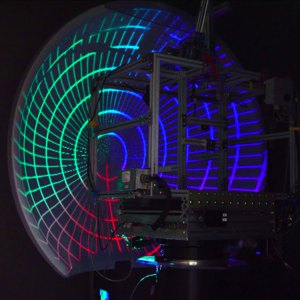
Another note to self: I don’t care what they call them in Wollongong, but I will not be calling them Sphemirs. And probably not Mirrordomes, though that is much better.
Dome projection using a spherical mirror
Variously referred to as “sphemir” or “mirrordome”,
Conceived by the author in 2003 [uwa.edu.au via city of sound]
The Making Of A John Chamberlain Sofa
More 1970’s video awesomeness from Anton Perich’s YouTube channel: this time it’s John Chamberlain with a flensing knife in The Dakota.
The site is a smallish, park-facing room in writer John Hersey’s Dakota apartment. Much of the space is taken up massive, chest-high foam blocks lashed together with cords, which a gruff Chamberlain, dressed in full Pacific Theatre-veteran style–work shorts, mermaid tattoos, back hair, and suspenders–casually carves into one of his trademark sofas as a clutch of jaded groupies look on.
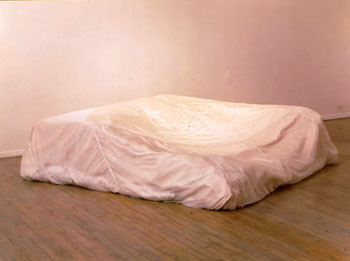
Unlike the low-slung prototype Chamberlain famously made for Donald Judd, Hersey’s couch stays high enough to climb into.; and it has two seating pits, not one; also, it doesn’t get the sleek, silk parachute cover, just a bunch of striped navy sheets, probably from Bloomingdale’s. Also, as far as I can tell, no one videotaped the inaugural line of coke being cut on Judd’s sofa.
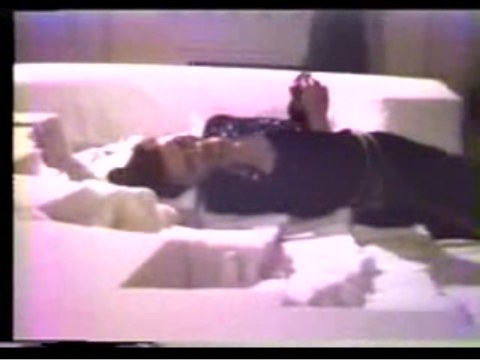
The scale of Hersey’s sofa, plus the rawness of its fabrication remind me of Andrea Zittel’s space-filling Raugh Furniture series in a way that both Judd’s and Yvonne’s more furniture-like sofas don’t.
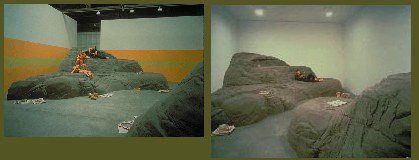
And watching Chamberlain, it’s impossible not to think of whale blubber being carved, either, which brings to mind–of all people–Matthew Barney. For all the car crashing of Cremaster 3 and the Vaseline-slice&molding of Drawing Restraint 9, I’d never thought of these two sculptors together before.
Anyway, if you’ve always wanted a Chamberlain sofa, but didn’t want to spend five figures for it, this is a great how-to video.
2025 update: Perich re-uploaded a slightly improved version from the one 16 years ago:
Cellarius’ Celestial Atlas, Harmonia macrocosmica
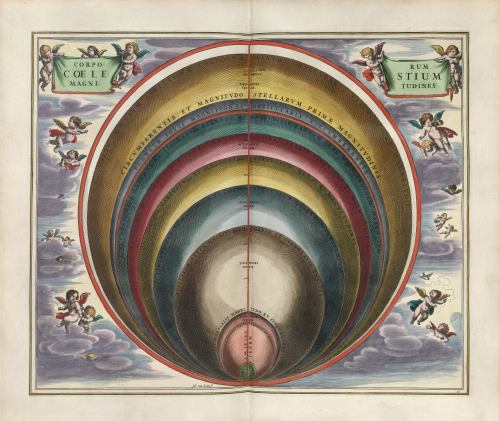
Christie’s is calling Andreas Cellarius’ Harmonia macrocosmica “PROBABLY THE FINEST CELESTIAL ATLAS EVER PUBLISHED.” But then, they would; they have a first edition from 1660 they’re hoping will sell for $80-120k next week.
Cellarius compiled the celestial maps of Ptolemy, Copernicus, and Tycho Brahe into one exquisitely illustrated volume which was reprinted first in 1661, then after Cellarius’ death in 1708, and in a couple of contemporary re-editions up to and including Taschen’s reproduction.
Plate 10 [above]: CORPORUM COELESTIUM MAGNITUDINES – The sizes of the celestial bodies.
Plate 17 [below]: SOLIS CIRCA ORBEM TERRARUM SPIRALIS REVOLUTIO – A map showing the pre-Copernican theory that seasonal changes were attributable to the sun’s spiral orbit around the earth.

LOT 50: CELLARIUS, Andreas (ca 1596-1665). Harmonia macrocosmica, est. $80,000-120,000, June 17 at Christie’s [christies.com]
There are several scans of Harmonia macrocosmica online: the University of Utah Library has one; and so does The Warnock LIbrary in A’dam. The images above come from scans at the extensive Cellarius site published by R.H. van Gent at the University of Utrecht.
Buy the Taschen reissue of Andreas Cellarius’ landmark 1660 celestial atlas, Harmonia macrocosmica, at Amazon [amazon]
PAGEOS: Second Generation Satelloon For Stellar Triangulation
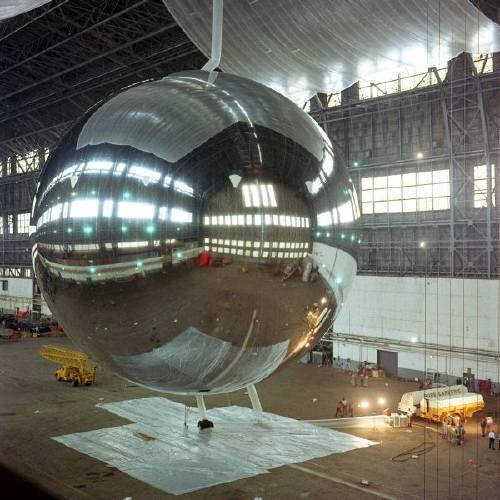
When I first discovered satelloons a few months ago, I admit, I was a little disappointed to have fallen so hard for the first generation satelloons of Project Echo. This disappointment kicked in when I saw this photo of the PAGEOS satelloon being tested before its June 1966 launch. It wasn’t much bigger than Echo I [31m vs 30m; Echo II was 40m]; what set it apart was PAGEOS’ incredible mirror-like skin.
Which, I find out, was by design. PAGEOS, short for PAssive GEOdetic Satellite, was used in the impressive-sounding Worldwide Satellite Triangulation Network, an international collaboration to create a single global characterization of the earth’s surface, shape, and measurements.
Geodesy, the science of measuring and representing the earth, helped identify things like plate tectonics and the equatorial bulge. From what I can tell, the WSTN involved taking pictures of the PAGEOS against identical star fields from different points on the earth’s surface, then backing out precise values for latitude, longitude, and elevation from the photos’ variations.
Stellar geodesy was obsoleted during PAGEOS’ lifetime by lasers [more on that later], but not before the WSTN, under the direction of the Swiss scientist Dr. Hellmut Schmid, was able to calculate the accuracy of locations on the earth’s surface to within 4m. According to Wikipedia, between 1966 and 1974, Schmid’s project, using “all-electronic BC-4 cameras” installed in 46 stations around the free world [the USSR and China were not participating for some reason], produced “some 3000 stellar plates.” Photographs of the stars with a 100-foot-wide metallic sphere–designed to capture and reflect the sun’s light, and placed in an orbit that provided maximum visibility–moving in front of them.
I’d love to see some of these plates, or find any useful reference sources beyond the kind of scattershot, autotranslated Wikipedia articles.
Balloon Satellite [wikipedia]
PAGEOS
Stellar Triangulation
Hellmut Schmid
Enzo Mari x Ikea Mashup, Ch. 2: Parts

In the early 1970’s, Enzo Mari suggested using 1-by pine lumber to make his autoprogettazione furniture because it was cheap, standardized, easy to cut, and universally available at the corner hardware store. Now, my local hardware is a Home Depot, and the boards they sell come from New Zealand. So in keeping with the spirit of Mari’s design, I’m going to use components from Ikea furniture kits instead.
The dining table I’m going to make is called either F or EFFE, depending on which plans you look at [Mari’s own autoprogettazione book uses the former; Peter Stamberg’s 1976 blueprint anthology, Instant Furniture, which reproduces four of Mari’s autoprogettazione designs, uses the latter.] It calls for wood in two sizes. The truss and leg structure is made of 1×2 in lengths ranging from 10 1/2″ to 51″. The top calls for four 79-inch 1×8 planks, which actually comes to about 30″ across. [After it’s dried and finished, 1×8 boards are usually 3/4″ x 7 1/2″. I had no idea.]
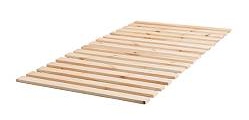
There turns out to be far fewer useful sources of lumber in Ikea than I originally thought. [The idea hit me when I passed giant warehouse shelves filled with rolled up pine bed slats.] But most of the pine pieces in Ikea furniture are only 1/2-inch thick, too thin to use for underpinning a table.
Though I stuck to pine on principle, there is some solid wood furniture, mostly birch, with some oak. But by far, most of the wood-looking furniture is made from veneered particleboard; who knows what’d happen if you cut it?

I don’t doubt you could make a quintessentially Ikea Mari table by using only these kinds of components; the sleek, plastic-over-sawdust goodness of Ikea’s signature Lack tables and shelves could make for a very conceptually tight mashup, but that’d be the second or third piece I’d make, not the first.
The other major constraint is the length of the boards for the top; only three products have decent width pine boards within range of 79 inches [which is 200cm, if you’re wondering why Mari picked that length]. The 5/8-in. thick sides of the tallest Trofast storage units [above] are either 11 3/4 in. or 17 in. deep, but only 69 in. tall. And some of them have regularly spaced grooves for sliding bins.
[Though it felt like cheating, I did check out readymade tabletops. The Vika Furuskog tabletop comes in pine, and is 78 3/4 in. long, but only 23 5/8 in. wide; too narrow to use, too wide to double up on.]

The new Mandal bed [king-size, $249] comes really close to being the perfect Mari table kit. It has a smoothly sealed headboard and footboard of solid pine, which, on the king size model, are each 78 in. long. The headboard is 23 1/2″ wide, and the footboard is 12″; placed top-to-top, they’d be 35 1/2″ wide, which isn’t too far off. As a bonus, they have both taper on the bottom edge, which would be nice on the underside of the tabletop. [There is a row of pre-drilled holes along the base of each piece, though, which kind of bugs.]
Mari’s table calls for more than 66 linear feet of 1×2 wood underneath. It’s close, but the Mandal’s inner support rails may provide enough wood without buying extra pieces. The siderails are smoothly finished, too, and each 78 in. piece is 3 in. wide on the outside face, tapering to 2 in. wide on the inside face. The unfinished pieces underneath the bed are either 7/8 x 1 3/4 in. [i.e., 1×2], or 1 3/4 square. Four 1 3/4 sq. pieces are 27 1/2 inches long, just 1/4-in. longer than the table leg specs. If more wood is needed, a $20, twin-sized Sultan Lade bed slat offers one of the best options for raw wood. The 15 slats are 2 3/4 x 3/4 x 38, with slightly beveled top corners.
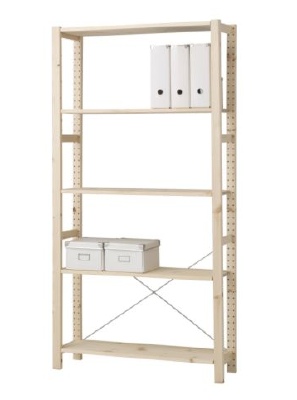
The Mandal has the added benefit of being factory sealed with a smooth acrylic finish. If it’s important to stick close to Mari’s original idea of unfinished wood, the far-and-away winner is the Ivar storage system. Ivar’s component-based, which means the shelves, side units, and corner posts may be all you need to make a table.
One pine top shelf [$19] is 3/4 x 11 3/4 x 82 5/8 inches Cut off the embedded metal brackets from each end, and it’s right at 79 inches. There’s also a vertical piece to cut off [or to not attach in the first place; the shelf I saw didn’t have it at all.] If you use three shelves, the table will be 35 1/4 inches wide, which adds 5+ inches to the horizontal pieces underneath the table, too.
Corner posts are 1 3/4-in. square and filled with drilled holes [$8, $12]. The side units are their own standard dimension–1 3/4 x 1 1/4 inches–which could be pulled apart and used as lumber. But it’s also tempting to use the ladder-like pieces whole. Both parts come in 70 1/4″ and 89″ lengths [$12, $15].
Maybe you could cut down [sic] on the sawing required by just making the table to Ivar’s dimensions instead of Mari’s. Then instead of a lengthwise shelf, you could build a top from shorter 33 x 11 3/4-in. shelves [$6] set crosswise.
I sit here trying to juggle the variables to the best effect: faithfulness to Mari’s original design; faithfulness to his concept, which is not quite the same thing; the inherent “Ikea-ness” of the inputs; the quality and utility of the output; the amount of tweaking, finishing, and labor required. And I repeatedly find myself creating a conceptual justification for the path of least resistance. All conceptual stunts being equal, I’m drawn toward the one that involves the least labor and mess. Which turns out not to be the same as requiring the least time, cost, or effort, as the 8-month over-analysis of making a simple table attests.
Enzo Mari x Ikea Mashup, Ch. 1

I wrote a few months ago about making a dining room table following Italian designer and theorist Enzo Mari’s 1974 Proposta per un’autoprogettazione, roughly translated as “A Project for self-design.” Mari’s goal was to effect a critical examination of the objects around us and the system of design, manufacture, distribution, marketing, and commerce that brings them into being. He did this by developing blueprints for a houseful of furniture that could be made from standardized pine lumber, in a day or two. The designs require only the simplest saw cuts and a hammer. And if you get the lumberyard to cut the lengths for you, it just requires a hammer. As Mari explained in an interview:
these items are not intended as alternatives to industrial ones, their creation is intended as a sort of critical exercise on design, and this is the reason why this experiment was called home design, not home production. The user, in repeating the operation, which can never be a slavish repetition…the designs have no measurements and while you are making them you can make changes, variations…when making the object the user becomes aware of the structural reasoning behind the object itself, therefore, subsequently he improves his own ability to assess the objects on the market with a more critical eye.
The EFFE table I want to build requires two sizes of board: 1×2 inch pine for the structure, and 1×8 planks for the top. In 1983, Mari explained that, “As regards material, the easiest to acquire is undoubtedly still the wooden plank.” Undoubtedly. So I headed down to the nearest hardware store, where there were several hundred varieties of curtain rod finials, but no lumber. I was told I could order pine boards of these dimensions, and they’d come in about a week. Couldn’t my contractor get wood for me? So I went to Home Depot, which had pine boards in several grades and dimensions. They were all from New Zealand.
First off, it wasn’t that nice-looking, but buying processed wood from the other side of the world in a 100,000-sf store seemed to contradict the spirit of the autoproggetazione project. Under those circumstances, Jeff Bezos’ critical response to the furniture design industry made more sense. [When he started Amazon, he made the desks out of hollow-core doors and sawhorses, a scrappy tradition the company continued.] But I didn’t want the aggressively cheap improvisation of a Bezos Table in my house.
The place where I saw the biggest piles of untreated pine lumber was, ironically, Ikea. The warehouse section near the store’s exit has palletsful of bookcases, chairs and beds, all flatpacked and ready for assembly [home production?] What would happen if you treat Ikea as your corner hardware store, and use their flatpack-optimized, mass-produced furniture components as the raw materials in an entirely different design?
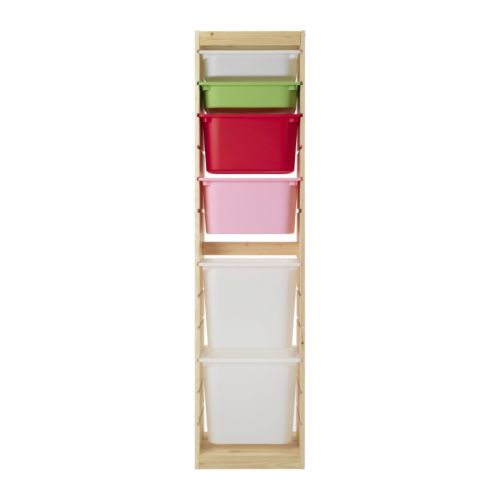

Looking through the Ikea hacking communities, it seems no one had tried to make an Enzo Mari table from Ikea parts before. While Ikea publishes detailed dimensions for their assembled products, there’s no information on part specs. Over the course of several trips to Ikeas outside New York and Washington, DC, I identified every Ikea product that looked like a promising source of pine parts, and I measured each piece of wood.
Though there are many pine products at Ikea, there are just eight products or series whose parts come close to standard 1-by lumber dimensions. I’ll put them in the next post. Then I’ll calculate the various combinations to figure out things like the optimum use of material, the least amount of cutting, the cheapest/most expensive, the closest to Mari’s design, and the most successful table. We’ll see how it goes.

related: the 2002 reprint of Autoprogettazione from Corraini is much harder to find than it should be [abebooks]
previously: Autoprogettazione: The Making Of An Enzo Mari Dining Room Table
Ceci N’est Pas Un Satelloon
But darned if it isn’t pretty damn close. La Géode is a mirrored geodesic dome housing a hemispheric Omnimax theatre. It’s part of the Cité des Sciences et de l’Industrie, a science museum opened in 1986 in Parc la Villette, which I confess, I only knew as the site of Bernard Tschumi’s red follies. [There are a couple visible in the background here, and judging from this photo from another angle, they’re rightupthere next to the dome.]
At 34m across, Adrien Fainsilber’s stainless steel-clad Geode is the nearest approximation to the physical presence of a Project Echo satelloon that I’ve found. [Thanks to Stuart, actually, who tipped me to the recent post on extremely impressive shiny balls on deputy dog.]
Fainsilber’s site has more pictures, including the grainy-nice snap of the Geode nearing completion. and this amusing explanation:
Symbole de l’Univers, le reflet des nuages suggère la forme des continents et offre une vision immatérielle de l’environnement.
L’écran hémisphérique de 26m de diamètre de la salle de spectacle a engendré la forme sphérique de l’enveloppe.Symbol of the Universe, the reflection of clouds suggests the form of continents, and offers an immaterial vision of the environment.
The hemispheric screen of 26m diameter in the salle de spectacle [heh] engendered the spherical form of the envelope
I love it, a loopy mix of grandiose over-symbolism and bureaucrat-pleasing rationalization. As if the shiny steel awesomeness of the dome was somehow just the unavoidable by-product of the program the humble architect received. [Qu’est ce qu’on a pu faire? C’est logique.] Sure beats the “but it’s art!” pitch that was the last straw for the suits backing the Pepsi Pavilion.
Also, it’s an amusing stick in the eye of the deconstructionist, “form before function” conceit that Tschumi and collaborator [sic] Jacques Derrida put forward for the rest of the park.
I don’t know the story of the creation of Parc de la Villette, but Tschumi sounds like the Robert Irwin to Fainsilber’s self-important Richard Meier. Looking at the landscaping, la Geode has gone from being a Symbol of the Universe to just one stop of Tschumi’s David Rockwellian Cinematic Promenade. Or to the electron on a hydrogen atom. Which, as I zoom in with the all-seeing Google Eye to watch the picnickers in the Parc, i realize is so true. What if the whole universe were just an atom under the fingernail of a giant?
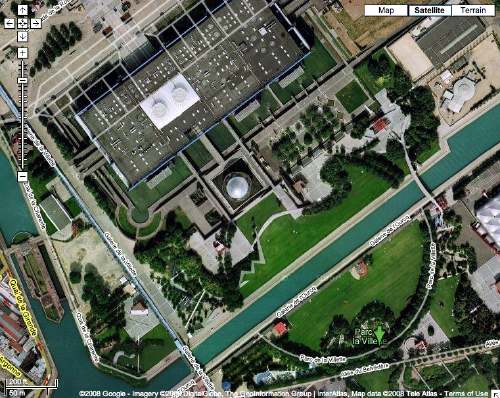
extremely impressiv shiny balls [deputydog.com]
Fainsilber > Realisations > CSI [fainsilber.com]
CSI and la Geode, and guests reading Le Monde, apparently, and letting their kids run wild [google maps]
Metaphysics of Parc de la Villette [gardenvisit.com]
Meanwhile, In The American Pavilion…

Here’s a description of the American Pavilion at the Osaka ’70 Expo from an online exhibit at Columbia called, “Housing The Spectacle: The Emergence of America’s Domed Stadiums”:
Trying to best R. Buckminister Fuller’s Geodesic Dome built for the U.S. Pavilion at Expo 67 in Montreal, the architects of the Expo 70 Pavilion first envisioned it as a huge floating sphere, inspired by NASA’s Apollo 11 mission that put the first man on the moon. This spherical scheme was the winning entry (submitted by Davis – Brody Architects and deHarak, Chermayeff & Geismar, Designers) in a competition sponsored by its future owner, the United States Information Agency (USIA). The competition scheme would have included exhibition space inside the sphere, and used its inner surface as a giant projection screen for continuously played film clips. The Pavilion ultimately erected at Osaka marked the birth of a new structural building type — the longspan, cable stiffened pneumatic dome — which would for a time become the predominant roof system over America’s emerging sports palaces. Remarkably, the U.S. Pavilion’s pneumatically supported 465 foot by 265 foot clear span dome was developed largely in response to Congress’ 50% reduction in the project’s budget. The completed Pavilion cost $450,000, which was about half the cost of the Montreal dome.
Those budget cuts meant The Great Balloon was replaced by a flat, quilted dome derided as “the world’s largest bunion pad.”
“Space balloons” were a prominent element in another of designs invited by the US Information Agency. According to an exasperated-sounding 1968 Architectural Forum review of ten of the eleven invitees, Isamu Noguchi proposed an underground exhibition space topped by a “vividly colored” and contoured playground landscape, comfortably shaded by a giant balloon. A space balloon.
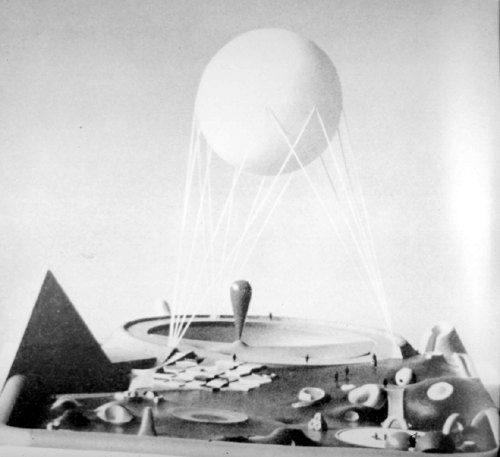
Davis Brody’s winning plan for the Great Balloon originally included a spiral exhibition-filled ramp leading up to a panoramic platform where films would be projected on the entire upper half of the dome.

When that didn’t work out, the quest for giant, space exploration-evoking spheres, though, seems to have been moved inside. I can’t make much sense of the exhibition design or its purpose from photographs [the clearest picture I’ve seen so far is a tourist’s snapshot], but there were certainly some Project Echo-esque Mylar spheres floating in there.
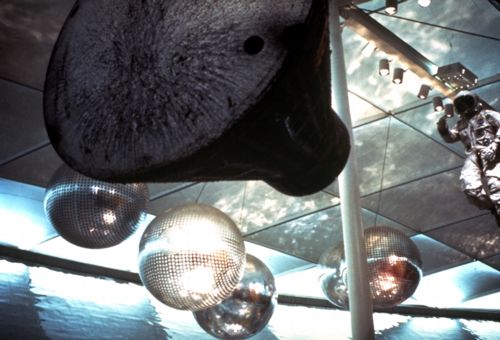
Also, the entire surface of the earth berm walls were covered in silver Mylar.
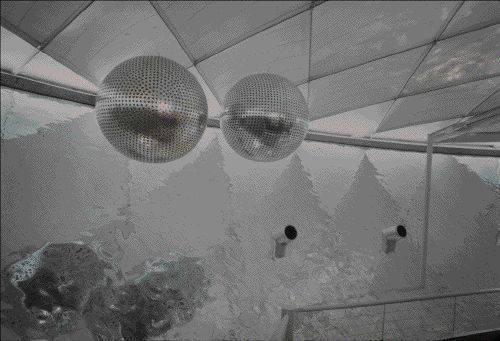
Especially with the dot-covered spheres, you see how short a trip it is from the Triumph of the Cold War and the Space Race to the Age of Disco.
There are more and larger images at the Columbia site. [columbia.edu]
The US at Osaka, Arch Forum, Oct. 1968 [hosted at columbia.edu]
Previously considered unrelated. Now? Helmut Lang’s self-portrait, a scavenged, battered disco ball
Q: Was The Pepsi Pavilion Art?
Of course, I’d only need to recreate The Pepsi Pavilion from Osaka 70 if it didn’t exist anymore. Does it? No. As relations between Pepsi and Billy Kluver, the engineer founder of E.A.T., deteriorated over issues of budget and esoteric programming [Pepsi had originally envisioned their dome-shaped pavilion as a site of a string of rock concerts to entertain The Pepsi Generation coming to the Expo], Kluver argued that the entire Pavilion was a work of art and thus, a success, and thus, worthy of continued expenditure and preservation. Pepsi, literally, wasn’t buying:
As an artistic experiment, though, it can be considered a success, and according to Klüver deserved to be treated as an art work.
In the case of the Pavilion, he therefore suggested to Pepsi-Cola to officially recognize the total work as an art work, in order to give it a legal structure. In a letter to Donald Kendall, President of Pepsi-Cola, Inc., he wrote “Our legal relationship to Pepsi Cola has developed so that the artists are put in the category of commercial artists designing a commercial product. One consequence of this is that we must obtain rights from all artists and engineers and others involved, particularly with regard to use of the Pavilion after Expo ’70. Of course, there is no question of Pepsi’s ownership and right to use and exhibit the Pavilion. Our dilemma is whether the artists have created a work of art or a work of commercial art to which there are rights which must be guaranteed… A decision to recognize the Pepsi Pavilion as a work of art and to treat it as such will set a much needed precedent in this area.” Pepsi-Cola never took this step and eventually the Pavilion was left in a state of gradual desolation and decay. This was certainly due to the fact that the relationship between E.A.T. and Pepsi-Cola had considerably cooled down, to the point that the company, the sole sponsor of the project, withdrew its support when E.A.T. presented a maintenance contract for $405,000, instead of the proposed sum of $185,000.
Too bad the strategy didn’t work; art seemed to be the only ticket to surviving the end of Expo 70. Today, almost all that’s left of Expo ’70 are Taro Okamoto’s massive sculpture, Tower of The Sun, and Kiyoshi Kawasaki’s International Art Pavilion, which until four years ago, housed the National Museum of Art, Osaka. Whoops, never mind: “The old museum was demolished and turned into a car park.”
From Ch. 2, “The Nine Evenings,” of M.J.M Bijvoets’ Art As Inquiry [stichting-mai.de]
No museums, but m-louis’s Expo70 photos do have sweet pavilions and the Tower of The Sun [flickr]
E.A.T. It Up: The Pepsi Pavilion
Let’s get one thing out of the way first: I’m a Diet Coke guy. The very fact that The Pepsi Generation existed in 1970 should blow a hole in their brand’s supposed youthy credibility big enough to drive a 90-foot mirrored dome though. Oh, and what do we have here?
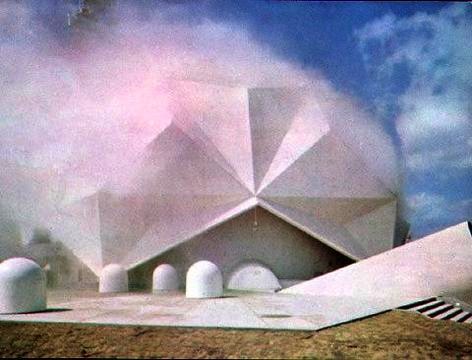
Holy freakin’ crap, why has no one told me The Pepsi Pavilion at the 1970 World Expo in Osaka was an origami rendition of a geodesic dome; obscured in a giant mist cloud produced by an all-encompassing capillary net; surrounded by Robert Breer’s motorized, minimalist pod sculptures; entered through an audio-responsive, 4-color laser show–yes, using actual, frickin’ lasers– and culminating in a 90-foot mirrored mylar dome, which hosted concerts, happenings, and some 2 million slightly disoriented Japanese visitors?
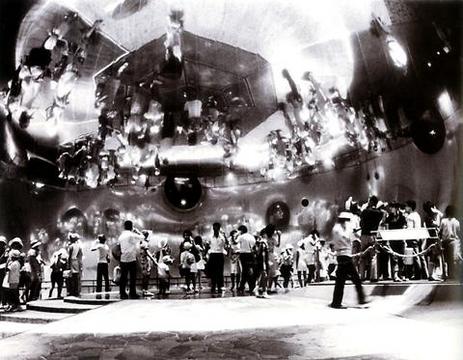
And that large chunks of it were conceived, developed, and programmed by E.A.T., Experiments in Art and Technology, the pioneering art/engineering collaborate founded by [among others] Robert Rauschenberg and Bell Labs’ Billy Kluver? And that the four artists working with Kluver–Breer, Frosty Myers, Robert Whitman, and David Tudor–had planned months of even freakier happenings for the Pavilion, but the Pepsi gave them the boot for being too freaky–and for going significantly over budget? Still.
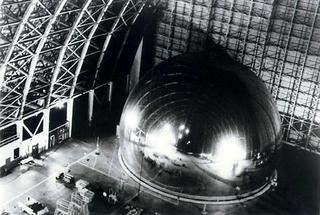
The least you could’ve done is tell me that Raven Industries made a full-size replica of the Pavilion out of Mylar and test-inflated it in a disused blimp hangar in Santa Ana, CA? Apparently, all it took was a 1/1,000th of an atmosphere difference in air pressure to keep the mirror inflated within the outer structure.
Because, of course, you know that Kluver was the guy at Bell Labs who helped Warhol with his seminal “Silver Flotations” exhibit in 1966 [seen here in Willard Maas’s film poem on Ubu]. And Bell Labs was involved in Project Echo, which launched and tracked two gigantic mylar spheres, satelloons, a couple of years earlier. Which makes the Pavilion’s similarities to the satellite below purely non-coincidental.
Which means that after recreating these two, earliest NASA missions as art projects, I’ll have to recreate the Pepsi Pavilion, too.
I’ve ordered by copy of Kluver et al’s dense-sounding 1972 catalogue, Pavilion and expect to be revisiting this topic in some depth within 5-7 business days. Meanwhile, if there are any other giant, mylar spheres of tremendous-yet-overlooked artistic and historical importance lurking out there, now’s your chance to come clean.
E.A.T. – Experiments in Art and Technology «Pepsi Pavilion for the Expo ’70» [mediaartnet.org]
Previously: Must. Find. The Satelloons Of Project Echo
D’oh, or else I must make the satelloons of Project Echo, which would mean I’m an artist, freak, or both
Autoprogettazione: The Making Of An Enzo Mari Dining Room Table
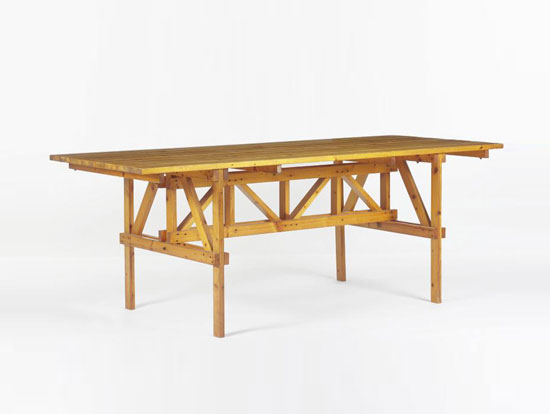
The economic and ecological and aesthetic far-sightedness of Enzo Mari’s 1974 Autoprogettazione still blows my mind. Translated variously as “self-projects,” and “self-design, self-made,” Mari’s collection of designs for furniture you could build yourself with just a hammer using cheap, off-the-shelf lumber anticipated several key design principles that resonate right now: DIY; sustainability; small-scale, local production and consumption; simplicity; handmade; hacking commercial products; and the open-source/creative commons movements [the furniture could be built by anyone except a factory or a dealer.]
Mari intended his Autoprogettazione to be made of #2 medium-grade, knotty pine, some of the humblest material on the market. He arranged for a company to pre-cut the lumber and sell it in packs as Metamobile. Naturally, one of these vintage 1974 kit tables sold for $14,400 at auction last fall.
Naturally, a gallery in Chelsea, Demisch Danant, just closed an exhibition of Metamobile furniture which they had made, and which they arranged for Mari himself to sign. Which seems to defeat several purposes of the entire Autoprogettazione concept, but that’s life.
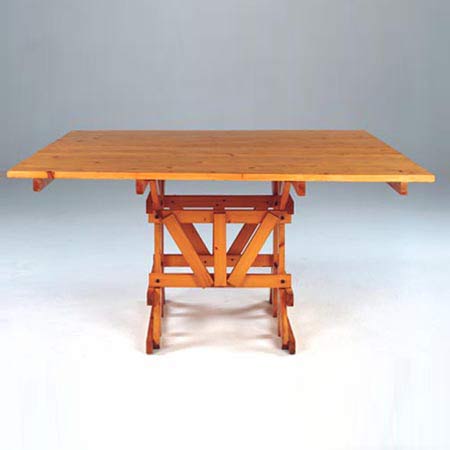
I’m looking for photos of the first Metamobile furniture I saw, which is still my favorite: In 2004, Rirkrit Tiravanija produced Mari’s square dining table [above] and some chairs in chrome-plated stainless steel. The pieces weighed a ton, but they were truly spectacular, like Koons picnic furniture.
Anyway, we’re just in the middle of moving our place in DC, which gives me the occasion to need a bigger, nicer dining room table. Mid-century modernism is too relentlessly tasteful; recent prices of “good” furniture make me laugh out loud. Though I’m an unrepentant Ikea fan, it only goes so far [i.e., no serious furniture]. Mari’s furniture feels like the perfect counterpoint to the homogeneous mega-catalogue stores: C&B, Pottery Barn, CB2, West Elm, etc. etc. etc.
So I’m thinking of getting the Truss Table [top] known as the EFFE Table. As a city dweller, I’d have to have it made, or at least have the lumber cut and finished and delivered for my own assembly.
An ex-pat design firm in Japan used sugi, Japanese cedar, to make their EFFE table. For me, I think it’s key to use Mari’s intended pine. So far, I’ve sourced two wildly disparate, but potentially interesting woods:
update: Those Demisch Danant pieces appear related to a series of 18 pieces put up at auction last June in Paris. Artcurial has a making of video, though they don’t actually show what they made. An EFFE Table went for EUR2,231.

